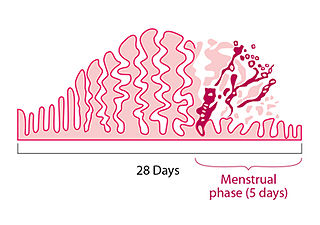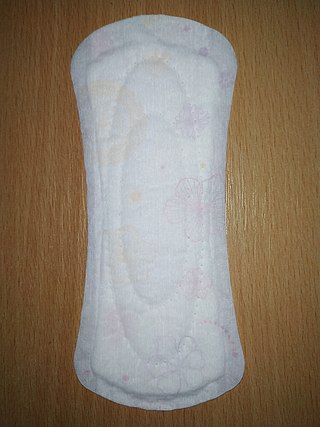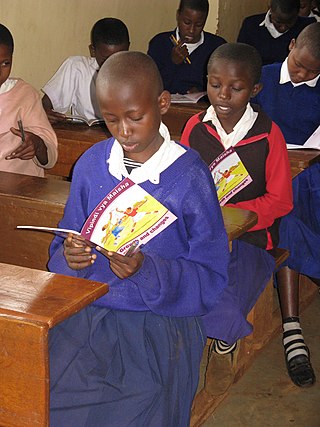Related Research Articles

Menstruation is the regular discharge of blood and mucosal tissue from the inner lining of the uterus through the vagina. The menstrual cycle is characterized by the rise and fall of hormones. Menstruation is triggered by falling progesterone levels and is a sign that pregnancy has not occurred.

A tampon is a menstrual product designed to absorb blood and vaginal secretions by insertion into the vagina during menstruation. Unlike a pad, it is placed internally, inside of the vaginal canal. Once inserted correctly, a tampon is held in place by the vagina and expands as it soaks up menstrual blood. However, in addition to menstrual blood, the tampon also absorbs the vagina's natural lubrication and bacteria, which can change the normal pH, increasing the risk of infections from the bacterium Staphylococcus aureus, which can lead to toxic shock syndrome (TSS). TSS is a rare but life-threatening infection that requires immediate medical attention.

A menstrual cup is a menstrual hygiene device which is inserted into the vagina during menstruation. Its purpose is to collect menstrual fluid. Menstrual cups are usually made of flexible medical grade silicone, latex, or a thermoplastic isomer. They are shaped like a bell with a stem or a ring. The stem is used for insertion and removal, and the bell-shaped cup seals against the vaginal wall just below the cervix and collects menstrual fluid. This is unlike tampons and menstrual pads, which absorb the fluid instead.

A menstrual pad, or simply a pad, is an absorbent item worn by women in their underwear when menstruating, bleeding after giving birth, recovering from gynecologic surgery, experiencing a miscarriage or abortion, or in any other situation where it is necessary to absorb a flow of blood from the vagina. A menstrual pad is a type of menstrual hygiene product that is worn externally, unlike tampons and menstrual cups, which are worn inside the vagina. Pads are generally changed by being stripped off the pants and panties, taking out the old pad, sticking the new one on the inside of the panties and pulling them back on. Pads are recommended to be changed every 3–4 hours to avoid certain bacteria that can fester in blood; this time also may differ depending on the kind worn, flow, and the time it is worn.

Kotex is an American brand of menstrual hygiene products, which includes the Kotex maxi, thin and ultra thin pads, the Security tampons, and the Lightdays pantiliners. Most recently, the company has added U by Kotex to its line of menstrual hygiene products. Kotex is owned and managed by Kimberly-Clark, a consumer products corporation active in more than 80 countries.

Feminine hygiene products are personal care products used during menstruation, vaginal discharge, and other bodily functions related to the vulva and vagina. Products that are used during menstruation may also be called menstrual hygiene products, including menstrual pads, tampons, pantyliners, menstrual cups, menstrual sponges and period panties. Feminine hygiene products also include products meant to cleanse the vulva or vagina, such as douches, feminine wipes, and soap.
Always is an American brand of menstrual hygiene products, including maxi pads, ultra thin pads, pantyliners, disposable underwear for night-time wear, and vaginal wipes. A sister concern of Procter & Gamble, it was first invented and introduced in the United States in 1983 by Tom Osborn, a mid-level employee at Procter & Gamble, then nationally in May 1984. By the end of 1984, Always had also been introduced internationally in the United Kingdom, Canada, France, Germany, Arab world, Pakistan and Africa. Despite the Always' pads runaway international success, Procter & Gamble almost fired Tom Osborn twice in the early 1980s as he was developing this product.

Cloth menstrual pads are cloth pads worn in the underwear to collect menstrual fluid. They are a type of reusable menstrual hygiene product, and are an alternative to sanitary napkins or to menstrual cups. Because they can be reused, they are generally less expensive than disposable pads over time, and reduce the amount of waste produced.

There are many cultural aspects surrounding how societies view menstruation. Different cultures view menstruation in different ways. The basis of many conduct norms and communication about menstruation in western industrial societies is the belief that menstruation should remain hidden. By contrast, in some hunter-gatherer societies, menstrual observances are viewed in a positive light, without any connotation of uncleanness.
Aisle is a Canadian company that manufactures washable feminine hygiene products, including cloth menstrual pads, period underwear, and menstrual cups.

Arunachalam Muruganantham (Padman) is a social entrepreneur from Coimbatore in Tamil Nadu, India. He is the inventor of a low-cost sanitary pad-making machine and is credited for innovating grassroots mechanisms for generating awareness about traditional unhygienic practices around menstruation in rural India. His mini-machines, which can manufacture sanitary pads for less than a third of the cost of commercial pads, have been installed in 23 of the 29 states of India in rural areas. He is currently planning to expand the production of these machines to 106 nations. The movie Period. End of Sentence. won the Academy Award for Best Documentary for the year 2018. The 2018 Hindi film Pad Man was made on his invention, where he was portrayed by Akshay Kumar.
Born in the early 1900s, Leona W. Chalmers is best known for inventing the first usable and available modern menstrual cup. She was also an actress and author who wrote the book The Intimate Side of a Woman’s Life.
Women's Voices for the Earth (WVE) is a feminist, women-led, North American environmental organization that specializes in research and advocacy regarding toxic chemicals used in products that disproportionately impact women's health, including cosmetics, menstrual care products, professional salon and cleaning products. WVE is a non-profit organization whose mission is to amplify women's voices to eliminate toxics that harm communities and health. With its inclusive vision of environmental work WVE has become a hub for visionary feminist environmentalism that recognizes the systemic connections between health, class, race, and the environment. Addressing the inter-connectivity of these various channels of exposure to toxic chemicals has been key to WVE's approach which is multi-scalar: targeting consumer behaviors, corporate practices, and government policies.

Tampon tax is a popular term used to call attention to tampons, and other feminine hygiene products, being subject to value-added tax (VAT) or sales tax, unlike the tax exemption status granted to other products considered basic necessities. Proponents of tax exemption argue that tampons, sanitary napkins, menstrual cups and comparable products constitute basic, unavoidable necessities for women, and any additional taxes constitute a pink tax.
Sustainable menstruation refers to the use of environmentally-friendly and responsible menstrual products.

Menstrual hygiene management (MHM) or menstrual health and hygiene (MHH) refers to access to menstrual hygiene products to absorb or collect the flow of blood during menstruation, privacy to change the materials, and access to facilities to dispose of used menstrual management materials. It can also include the "broader systemic factors that link menstruation with health, well-being, gender equality, education, equity, empowerment, and rights". Menstrual hygiene management can be particularly challenging for girls and women in developing countries, where clean water and toilet facilities are often inadequate. Menstrual waste is largely ignored in schools in developing countries, despite it being a significant problem. Menstruation can be a barrier to education for many girls, as a lack of effective sanitary products restricts girls' involvement in educational and social activities.
Brenda Mallory is a Native American visual/sculpture/mixed media/installation artist and a member of the Cherokee Nation. Her artwork ranges from small decorations to large sculptures and utilizes a variety of materials such as handmade papers, cloth, wax, and recycled objects.

Period underwear are absorbent garments designed to be worn during menstruation. Period underwear is designed like conventional underwear but it is made up of highly absorbent fabrics to soak up menstrual blood. Most commercially manufactured period underwear makes use of microfiber polyester fabric. It is recommended that period underwear should be changed every 8-12 hours to avoid leakage and infection.
Eco Femme is a women-led social enterprise in Tamil Nadu, India, that produces organic washable cloth pads. Eco Femme was founded in 2009 in Auroville by Kathy Walkling and Jessamijn Miedema who started by producing, applying and selling these washable menstrual pads in Auroville. The aim was to produce pads that are both affordable and free of plastic. They were also interested in designing a sustainable alternative to disposable pads for the women of India as well as setting up self sustaining initiatives in cloth pad production for women from the neighbouring villages. All commercially sold pads are organically certified under GOTS and Eco Femme is the first in this space to have achieved this certification. The cloth pads are mostly made out of organic cotton and can last up to 75 washes or for three to five years from the time of purchasing. These pads are sold in more than 20 countries across the world. By 2022, Eco Femme has distributed over 1 million cloth pads which consequently saved more than 75 million single use disposable pads from reaching landfills.

Period poverty is a term used to describe a lack of access to proper menstrual products and the education needed to use them effectively. The American Medical Women's Association defines it as "the inadequate access to menstrual hygiene tools and educations, including but not limited to sanitary products, washing facilities, and waste management".
References
- ↑ Koskenniemi, Aino (2 January 2023). "Say no to shame, waste, inequality—and leaks! Menstrual activism in the market for alternative period products". Feminist Media Studies. 23 (1): 19–36. doi:10.1080/14680777.2021.1948885. hdl: 10138/357657 .
- ↑ Haneman, Victoria J. (February 2021). "Menstruation Capitalism, Period Poverty, and the Role of the B Corporation". Columbia Journal of Gender and Law: 7. doi:10.2139/ssrn.3778969.
- ↑ Loux, Renee (2008). Easy Green Living: The Ultimate Guide to Simple, Eco-Friendly Choices for You and Your Home. Rodale. p. 224. ISBN 978-1-62336-324-6.
- ↑ "Natural Products Report". Yoga Journal. January 2014. p. 72.
- ↑ Patterson, Ashly (2014). "The Social Construction and Resistance of Menstruation as a Public Spectacle". Illuminating How Identities, Stereotypes and Inequalities Matter through Gender Studies. Springer. p. 105. ISBN 978-9401787185.
- ↑ Bergin, Mary (May 17, 2004). "Organic Choices Just Keep Growing". The Capital Times. Archived from the original on September 24, 2015.
- ↑ "GladRags". Feminist Bookstore News. 20: 54. 1997.
- ↑ Garrett, Leslie (9 February 2011). The Virtuous Consumer: Your Essential Shopping Guide to Supporting Family, Friends, Neighbors — or Yourself. New World Library. p. 17. ISBN 978-1-57731-810-1.
- 1 2 Madden, Alanna (July 26, 2021). "Reusable period products more relevant than ever for Portland's GladRags". Portland Business Journal.
- 1 2 3 4 Woodstock, Molly (January 7, 2015). "10 Reasons to Love Portland-Based GladRags". Portland Monthly.
- ↑ "Size Matters: How the XO Flo Mini Menstrual Cup Saved My Vagina Feelings". Autostraddle. September 21, 2018.
- ↑ "Safe simple smart try GladRags or the keeper menstrual cup". Natural Health. December 1, 2005. Archived from the original on September 24, 2015.
- ↑ Mortenson, Eric (May 20, 2013). "East Portland floor company owner named Oregon's small business person of the year". The Oregonian.
- ↑ "Summer of Grrrl". The Star Press. 1999-06-30. p. 41. Retrieved 2023-08-13.
- ↑ Garrett, Leslie (2011). The Virtuous Consumer: Your Essential Shopping Guide for a Better, Kinder, Healthier World. New World Library. p. 17. ISBN 978-1-57731-810-1.
- ↑ Lozanova, Sarah (2023-03-15). "5 Zero-Waste Period Products". Earth911. Retrieved 2023-08-13.
- ↑ Ashford, Teresa L. (June 2, 2003). Recounting, rethinking, and reclaiming menstruation (Thesis). Oregon State University.